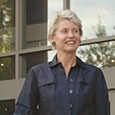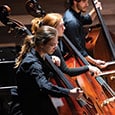Cynthia Johnston Turner isn’t afraid to shake things up. She knows that while the wider world changes rapidly, the basics of band rehearsals have stayed the same over the past century. She embraces change by bringing the latest technology into the music room, using innovative rehearsal techniques, and tearing down the invisible wall between conductor and ensemble.
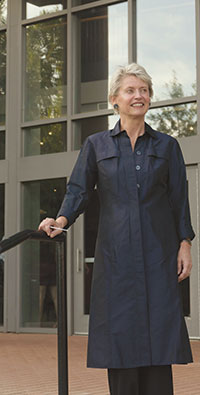
photo by Camille Hayes
What are your favorite rehearsal techniques?
For the last several years, I have rehearsed with the score on my iPad and projected behind me on a screen. When I started this approach at Cornell, it quickly changed how I rehearsed because students could see the big picture. Rehearsals become more efficient and engaging for students. Now, the grad students at the University of Georgia have iPads and zoom in on the score and circle things as we talk about them. We change the dynamics right there on the score.
Projecting the score lets everyone from the third clarinet player to the marimba player in the back see how individual parts fit into the whole. Some directors have criticized projecting the score. They note that music is an aural art, and the goal should be to listen on deep levels. Of course, that is true, but I argue that music touches all of the senses, not just our ears. At least 60% of students under our care are visual learners. They appreciate seeing what they are hearing or not hearing.
My work with digital scores started when I was a Google Glass Explorer at Cornell. Tyler Ehrlich (now teaching band and music technology at Centennial High School in Roswell, Georgia) and I developed a series of applications for this new technology. One was to embed the score in the Glass. I had the score directly in front of my eye but could only see a small amount on the screen. We ended up developing something we called the salient score with just the basic information and I would projected the score from my Google Glass behind me. What we really need is a digital music stand. At the University of Georgia, we’ve recently partnered with Newzik as the first school in the USA to beta test a new technology. The software allows the players to flip back and forth between the score and their part. In addition, if I make a marking on the digital score it will automatically appear on the parts. In my view, this is a breakthrough – and long overdue.
Would your approach to projecting the score change at all if you were working with high school students?
No, the sooner that we can encourage students to see and hear the big picture, the better. I have used the technique with honor bands, and it is a revelation for them. It is often the first time they have seen the score. The choral world is way ahead of us on this.
You frequently adjust seating arrangements in rehearsals. Which set-ups are your favorites?
Any time we can alter our perspective, it is a good thing. It makes us smarter, better and even more empathetic. I often talk about how if you plucked a gentleman from the 19th century and put him into the noise and lights of Times Square in the present day, he would be completely freaked out until he went into a classroom. Then, he would know exactly where he was, where to sit, and what to do. We haven’t changed all that much. If you took a trombonist from the Sousa band and put him in my rehearsal he would know where to sit. (However, he might wonder why so many percussion players were present.)
We use a scramble rehearsal maybe two or three rehearsals after the first sightreading. Students cannot sit in their normal row or next to a like instrument. Invariably tubas come to the front row and the piccolo and flute players go to the back. This is not just for fun, although the students love it. We talk about how this set-up changes how we hear and keeps me from giving cues to sections because it would look ridiculous. The tubas talk about having to listen back and the flute players have to listen forward. It expands our level of listening.
Sometimes we use circle rehearsals with the percussion or me in the middle. This rehearsal is student-driven. When students hear something to fix, they have to describe what they hear and suggest how to fix it.
I have also taken the first two rows and had them turn their chairs around and play to the back two rows. When students feel comfortable I will have them turn their stands around so that they are memorizing their music. The rule is they have to keep going even if they make a mistake. They have to improvise.
For a long time I have had concerns about how large ensembles have traditionally been taught. Conductors stand on a box with a stick, pick the repertoire, and tell students what to do, when to do it, and how to do it. Nonetheless, our music advocacy folks say that what happens in a band room is different from what happens in a math class. I beg to differ.
In math, they get a chapter of the book, they do the homework, and then they have an exam. In the music classroom, we give students a textbook chapter (repertoire), we put on a concert (the exam), and then start all over again. I do not believe that instills a love and appreciation for quality in music as much as it could.
That has led me to a real pedagogical crisis. We have been teaching band in the country for 100 years, but where are our audiences for band concerts? If we have instilled the love for music and band repertoire over all these years of teaching band in middle school and high school, people should be flocking to the concert hall. We can blame all sorts of things for that. It led me to think about more engaging and creative ways to involve the students in everything from choosing repertoire to decision making for the actual rehearsal and performance.
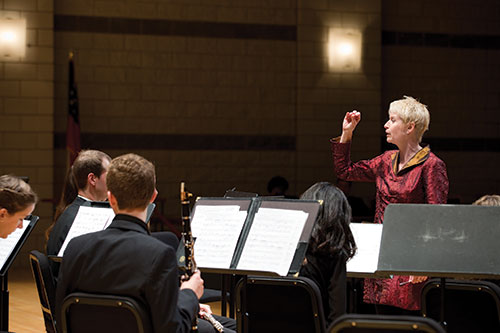
How do you instill a love of music in students?
One key is repertoire. We have to teach students what quality is and put the highest quality music in front of them all the time. We need to do a better job of helping students to develop their own criteria for what makes great art.We don’t have enough of those discussions and we should.
That’s why programming is so time-consuming and doesn’t get any easier. The music I choose for honor bands is high quality and while we are rehearsing it, I point out the parts of it that make it good music. Rolf Rudin’s Dream of Oenghus is one piece that I like to program. The music is highly repetitive but with a well-crafted melody. Rudin uses such a variety of color and textures that it keeps listeners and players engaged. The piece combines predictable and surprising elements.
Quality is not just because you like a piece or it has stood the test of time. That’s not good enough. We have to consider why has it stood the test of time. Conductors help students define and develop their ideas about what makes great music. The more we can do that, the less they are going to appreciate unsatisfying music.
You have taken your groups out of the rehearsal room for tours. How has your approach to touring changed?
When I was a high school band student in Canada we always left during our spring break, when it was still snowy and cold. We traveled south to the United States. These tours gave us a taste of life as a professional musician. We got on the bus and had arduously long bus trips. We got off the bus, met our host family, and played a concert that night. The next day we traveled to a new community and repeated the process.
Some of my fondest high school memories are from those tours. The music-making was a big part, but the community-making was just as important. Friends from those tours are still friends today because of the bonds we created. They were fun tours that also pushed our boundaries. After long days of traveling and playing nightly concerts, you have to dig deep and find that inner strength to make it happen as an individual player and an ensemble.
When I became a music educator, I wanted to create those same experiences and transformations for my students, and it took time to get it right. I tried many tours with my high school wind ensemble with moderate success, but in 1996, I finally got it right, and it was magical. One difference was that I spent more time developing students’ potential for leadership. I trained students in leadership from the beginning. We discussed how to identify signs of loneliness, reduce social cliques, build community, and make connections.
It was essential to travel on one bus. Long bus trips can either build community or destroy it. Student leaders were charged with leading community building exercises on the bus trips. One amazing game they developed was Secret Friends. Each student pulled a name for a secret friend and revealing your identity was forbidden. Secret friends did not have to spend a lot of money. You could send a poem or riddle. When we stopped at a rest stop, a secret friend might buy a fun little puzzle. Enthusiasm for the game spread throughout the tour. We revealed the secret friends at the end.
In my years as a college director, I have tried to incorporate service into our tours. When I taught at Cornell, our first tour was a life-changing trip to Costa Rica. The germ of that idea came from a cousin who had retired to Costa Rica years before. They were doing some outreach work and they found a little music school that had ten instruments and 40 students.
I shared the idea for a tour with a core group of student leaders. They put their heads together and embraced the idea of providing instruments for the music school. Students were charged with getting as many instruments as they could. They put up posters and sent emails to generate support. Students went to their former band directors and churches for donations. There is an amazing number of instruments sitting in hall closets and attics. In the meantime, I partnered with the local music store, Hickey’s Music Store in Ithaca, New York. The owner loved this idea and agreed to repair any instruments that came in for free.
We took 50 instruments on that first tour and managed to keep it a secret that we were donating them at the end. We worked with these little kids in Matapalo, Costa Rica, and told them they could borrow our Cornell instruments while we taught them. At the end of the day we put on a concert and even worked out something to play together. The whole community came – there must have been 300-400 people on this dirt floor soccer field/concert hall. At the end of the concert, we said, “By the way, you can keep the instruments.” The Cornell students went across and left the instruments for the Matapalo kids and, of course, everyone was crying. All I had to do was look at the Cornell kids to realize how special the experience was.
Two years later, we took about 75 instruments and we went to three communities. Two years after that we brought over 100 instruments to five communities. It just grew. Before my last tour there, I had done some guest conducting with the national youth orchestra. The local stakeholders identified five talented local musicians to join the Cornell Wind Ensemble for the tour and help with the teaching. One of the selected musicians had a flute that we donated two years before. He had continued playing and become a phenomenal flute player. The Cornell student who donated the flute was still in the wind ensemble. They are life-long friends. That kind of community building across cultures and borders is what music can do.
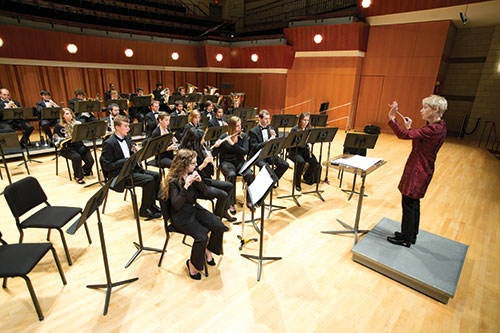
As you work with undergraduate and graduate conducting students, what advice do you find yourself repeating?
Be yourself. I see a lot of posturing on the podium as students try to look and be like somebody else. Figuring yourself out can be a life-long journey. I know it took me a long time. The self is constantly changing and evolving. The process starts with some soul searching. Often it involves writing down their thoughts from rehearsals, watching their conducting videos, and determining what they like and don’t like. Students often conduct a certain way, but when I talk with them in a relaxed setting, they speak differently
Conducting students also have to become more aware of the different ways their bodies move on the podium. I am encourage my students to take classes in movement, whether that is dance, yoga, tai chi, Alexander technique, acting, or public speaking. Often the things that make people better conductors aren’t related to conducting. They are related to psychology, self-analysis, body awareness, and mind awareness. These areas help people become more intuitive about who they are. As young conductors grow more comfortable on the podium, they learn that it is okay to be vulnerable.
Why is vulnerability important to conducting?
The era of the dictator on the podium is over. The professional musician in today’s society will not tolerate that kind of authoritarianism on the podium. Belittling and abusing players just doesn’t fly. What vulnerability means to me is being open to the players’ opinions, being open to taking risks and perhaps failing, and being open to admitting a mistake. One or two of my teachers never admitted to making a mistake on the podium, even when it was obvious. They didn’t want to be seen as weak in any way, but not admitting a mistake is weakness.
We do not generally march and play in Canada, so the marriage between sports and music in Canada isn’t as solid as it is here. Friday night marching band is not even a concept in Canada. There are drum corps in Canada, but the cold weather limits the marching season.
Based on my experiences in British Columbia and Ontario, there is much more of a focus there on process and product. The product is a performance and not to support athletic teams. It blew my mind the first time I stepped into an American band room to see all of the trophies. In my opinion, that is a problem. If there is too much focus on trophies and contests, we have lost sight of what art and music making is about. I know that is a controversial statement.
That doesn’t mean we shouldn’t have standards or assess students, but music should not be about winning and getting the big shiny trophy. That isn’t even an issue in Canada. We do not have administrators in Canada saying, “Where are you trophies?” That would never happen.
